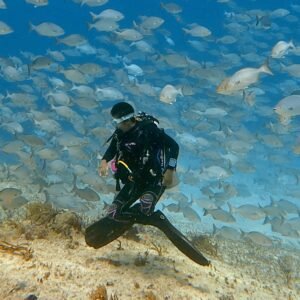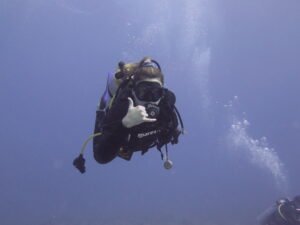Welcome, fellow diving enthusiasts! Whether you’re an experienced diver or just dipping your toes into the underwater world, understanding the language of scuba diving is essential for a safe and enjoyable experience. Welcome to the ABCs of Diving, where we will explore different scuba diving terms as we go through the alphabet. To read previous posts from this column check out our other blogs. Today we continue with the part 1 of the letter D:
DAN (Divers Alert Network): DAN is a nonprofit organisation dedicated to dive safety. They provide emergency medical advice, evacuation assistance, and research on diving-related injuries and illnesses.
Deco Mix (Decompression Mix): Deco mix refers to the gas mixture used during decompression stops to off-gas nitrogen absorbed during a dive. It typically consists of a blend of oxygen, nitrogen, and sometimes helium to reduce the risk of decompression sickness.

Decompression Sickness (DCS): Decompression sickness, also known as “the bends,” is a condition caused by nitrogen bubbles forming in tissues or bloodstream due to rapid ascent or inadequate decompression after a dive. Symptoms range from joint pain and skin rashes to neurological issues and can be serious if not treated promptly.
Decompression Stop: A decompression stop is a pause during ascent where divers remain at a certain depth to allow excess nitrogen to safely off-gas from their bodies. The duration and depth of these stops are calculated based on dive profiles and dive tables or algorithms used by dive computers.
Deep Diving: Deep diving involves exploring depths beyond the recreational diving limit of 40 meters (130 feet). It requires specialized training, equipment, and procedures due to increased risks such as nitrogen narcosis and longer decompression times.
Depth Gauge: A depth gauge is an instrument that measures the depth of a dive in meters or feet. It helps divers monitor their depth to stay within safe limits and manage ascent rates.

Dive Computer: A dive computer is an electronic device worn by divers that continuously monitors depth, dive time, and nitrogen absorption. It calculates safe ascent profiles in real-time, reducing the need for dive tables and providing enhanced safety by minimizing the risk of decompression sickness.
Dive Flag: A dive flag, typically a red flag with a white diagonal stripe, indicates the presence of divers in the water. It’s displayed on boats or floats to alert other watercraft that divers are submerged nearby, promoting safety and awareness.
Divemaster: A divemaster is a certified diving professional who leads and guides divers during recreational dives. They are trained in dive leadership, safety procedures, and underwater navigation, ensuring a safe and enjoyable diving experience for all participants.
Dive Tables: Dive tables are printed or electronic tools that provide guidelines for planning dives and managing decompression stops. They calculate safe dive times and depths based on the theory of nitrogen absorption in the body, helping divers avoid decompression sickness.
Diving Signals: Effective communication underwater is vital, and diving signals are hand signals or gestures used by divers to convey messages to their dive buddy or group. Signals can indicate directions, safety checks, emergencies, or simply points of interest, fostering clear communication without the need for verbal interaction.

Drift Diving: Drift diving involves descending into a current and allowing it to carry divers along a planned route. It’s popular in areas with strong currents or where the underwater terrain is best explored by moving with the flow. Proper planning and safety measures are essential for drift dives.
Dry Bag: A dry bag is a waterproof container used to keep personal items dry during dives, such as clothing, towels, electronics, and snacks. It’s essential for protecting valuables from water damage while aboard boats or during surface intervals.
Dry Suit: A dry suit is a full-body garment worn by divers to stay dry and insulated in cold water. Unlike wetsuits that allow a thin layer of water to enter and warm against the body, dry suits are sealed to prevent water ingress, keeping the diver warm in chilly underwater environments.
Scuba diving offers a unique blend of adventure, tranquillity, and discovery beneath the waves. By familiarizing yourself with these diving terms, you’ll enhance your understanding of the sport and contribute to a safer and more enjoyable diving experience. Whether you’re exploring coral reefs, wrecks, or unde


